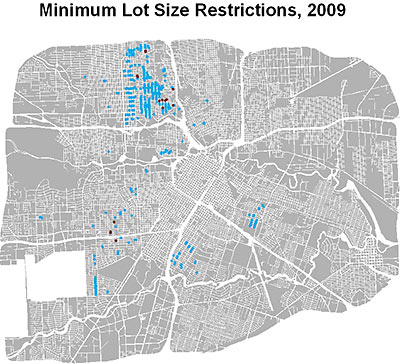
Using data from Houston’s planning department, University of Maryland grad student Chris Dorney has put together a series of diagrams showing which blockfaces in the Inner Loop have restricted lot sizes — and when they’ve done it. His maps start in 2002, when the predecessor to the city’s current Minimum Lot Size ordinance first went into effect. The ordinance allows residents of a single side of a single block to restrict homeowners in that block from subdividing lots below a certain size; its cousin, the Minimum Building Line ordinance, does the same for front setbacks. Dorney explains:
Each [diagram] shows the Inner Loop and indicates blockfaces with special minimum lot size restrictions already in place (red dots) and new for the given year (blue dots) (i.e. blue dots turn red the following year). There are clear spatial patterns to the adoption of these ordinances which it would be interesting to know more about. Perhaps most interesting to people from zoned cities is why every block has not decided to enact such restrictions…a zoning ordinance would likely cover every block uniformly.
And here they are:
***
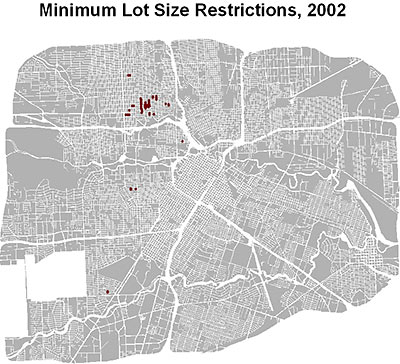
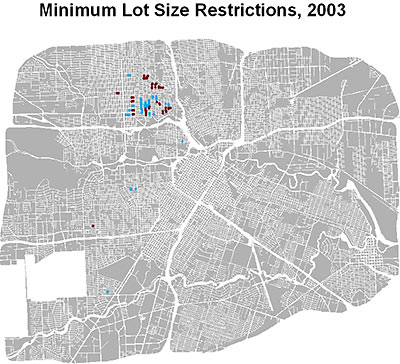
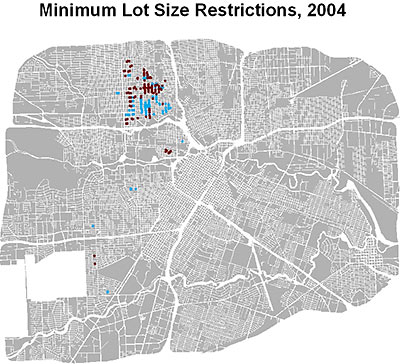
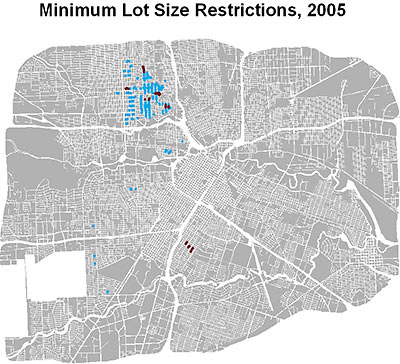
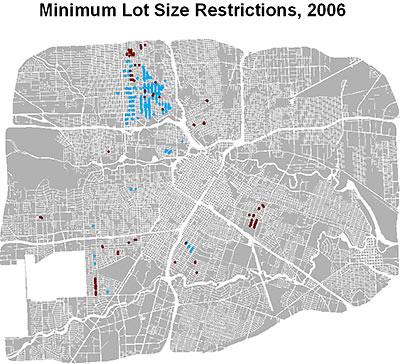
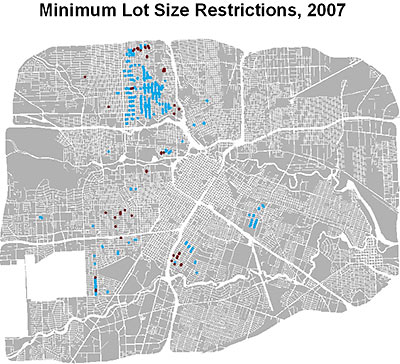


Dorney says he’s interested in the ordinance because it’s “citizen driven at a fine scale.” And he has a few questions for Swamplot readers:
- Based on the maps, what demographic [is] most likely to be against densification and why do they see density as being a bad thing?
- Why hasn’t every eligible blockface decided to enacted special minimum lot sizes? Is there a lack of awareness or do other demographics see their interests threatened with the enaction of such rules (e.g. for property rights or financial reasons)?
- Any interesting stories people want to share about blockface battles amongst neighbors over enacting these restrictions?
- Minimum Lot Size (MLS)/Minimum Building Line (MBL) Ord. [Planning and Development]
Diagrams: Chris Dorney





Many of these efforts (minimum lot size and setback) have been carried out by amateurs who do not have the proper expertise. A few years ago I had a client who was looking to develop property in the 1800 block of Columbia, in the Houston Heights.
It turns out that the block face had a minimum setback, but the setback established was in excess of 30 feet, even though most of the houses on that block were set back about 20 feet. Turns out that the volunteers who put together the submittal did not understand what they were measuring, with some of them measuring from the edge of pavement or sidewalk, rather than the actual property line, while others measuring to the face of the building, rather than the structure of the porch.
When the error was pointed out to the planning department, they shrugged their shoulders, said they were sorry, but that there was nothing they could do about it, as it was enshrined in an ordinance passed by city council. Property owner was screwed, big time. The lesson is that these block by block initiatives need to be done very carefully, and owners should be very careful about what they sign.
When I did my MLS MBL for my block, the planning dept came out and double-checked the setback numbers I had provided.
Everybody on my block but the home that is somebody’s business office signed their approval. This business owns that house and a vacant lot on the block, they have no investment in their properties as their homestead. The actual owner, one of three who office there, lives in Sugarland.
I live in the Windermere subdivision, or the vertical strip on land southwest of Rice University as visible on the map above. I bought my house after the neighborhood put in the MLS, but I am grateful for it. In my opinion it shows that our 1930s neighborhood values our homes as much as our land, and it keeps our neighborhood free of multi-story townhouses. Windermere has great character. We’ve had very few tear-downs and yet our property values keep increasing. I like that!
Perhaps most interesting to people from zoned cities is why every block has not decided to enact such restrictions
——————————————–
Not every block has them because not every block wants them. Many Houstonians welcome lot splitting and townhouse development.
Lots of streets are filled with piece of shit, falling down, termite infested, structurally unsound, obsolete, and flat out ugly houses. In these areas, townhomes are a welcome re-development. In these areas, the inability to split lots would mean lower land prices, decreased redevelopment and continued decay for decades to come.
The restrictions also encourage sprawl so they are anti-green.
I’ll assume Chris isn’t entirely familiar with the city, so based on the maps, the majority of MLS designations have been in the Heights, the area (roughly) border by I-45, I-10, I-610 and Shepherd Dr.
This is an area that was originally constructed at relatively low density in the early part of the 20th century, typically single family homes on 50-ft frontage (5000 to 7000 s.f.), many of which were small-ish bungalows (1000-1300 s.f.). This area has gentrified quite a bit over the last 10 to 20 years.
That gentrification has largely taken one of two forms. The first is renovation and expansion of existing structures, which maintain the overall population density, albeit with a larger home size. The second is demolition of the original structure(s) and subdivision of the lot(s). The new homes are typically single-family, 2-story on 25 or 33 ft frontage, though occasionally you see townhouses built at even higher density.
A typical situation would be a 1000-s.f. bungalow on a 6600 s.f lot demo’d and replaced by two 2-story 2200 s.f. homes, each on 3300 s.f. Those seeking MLS protection want to prevent this scenario, as they find it visually unappealing to see a relatively high-density lot next to a relatively low-density lot.
The reason every block hasn’t done this yet? Probably a combination of not knowing they can, not wanting to go through the effort, not being concerned about densification, or not wanting to harm their property values. This last is especially true when a property is currently only worth its land value, as a sub-dividable property is worth more to a developer than a non-sub-dividable one.
Division of lots into small strips has resulted in (1)Front trash cans since the builders didn’t leave enough room or provide a shielded area for the cans. Yes go ahead and pay $300-$400K–or more–for that. …and (2) Parking on the street, making navigating a two-lane residential street hazardous, making visibility when backing out of driveways hazardous, and (3) Parked cars that block sidewalks, detouring pedestrians into the street. Why people don’t use garages for their intended purpose is beyond me. One more (4) Car break-ins.
Haha I have an interesting story about our block, but someone I disagreed with already posted about it above – so in the interest of civility, I will not reopen closed wounds by leaving out specifics.
In our case, the demographics were clearly split down the young/old divide. By young vs. old I mean people steadily employed, typically under 50 yo, vs. retired people.
In our case, the younger people preferred new (actually any) development in the decaying neigbhorhood, while older people seemed more interested in maintaining a semblance of what once was.
I believe Angostura’s post lists exactly why some would not support minimum lot size ordinance for their block. When the property’s value is largely the value of the land then a sub-dividable property is worth more to a developer than both the land and improvements to anyone. It is not about density being a “bad thing”. It is about property value.
Like Emme I collected signatures to implement MLS for my block. If my property had been located in say, West End instead of the Norhill Historic District I would not have signed the petition myself. In Norhill, with a large majority of conforming and maintained structures, the value of my property (both land and improvement)is enhanced by a MLS ordinance. In the West End, no deed restrictions, delapitated structures, my value is in the land.
When the big houses are built they cancel any value the home had. So you may think property values go up with gentrification, the home value is made nil, thereby making it economically unattractive to improve your home for yourself while increasing it’s value. Gentrification of the type we are seeing in the Heights makes perfectly good and in demand homes into teardowns.
“Gentrification of the type we are seeing in the Heights makes perfectly good and in demand homes into teardowns.”
—
If they were in demand, they wouldn’t be teardowns. With a few notable exceptions, most of what gets torn down is pretty decrepit. Lot value for a full size (6600 sf) Heights lot is around $200k. Properties with livable structures on them usually go for more than this ($250-300k), and many end up being tastefully remodeled and expanded. Our next door neighbors did exactly this, and the result looks great. Ditto for the couple across the street (though they essentially only kept the facade and garage).
—
Think of it as “a rising tide lifts all boats,” except for the ones that aren’t seaworthy.
I have often wondered… Why is there such a collective push towards “improving property value”? I think it’s a terrible thing!
My preference is for the value of my property to stabilize. I don’t want it to fall, because it would make the neighborhood as a whole lose value and therefore invite blight; but I don’t want it to rise either, because I will simply have to pay more taxes on it. The only reason for anyone to hope for their property value to rise is because they would prefer to sell it. In my opinion, that’s not a sustainable model, because the only ones that benefit from it are the ones that do not want to keep the house long-term. That’s how you end up with sub-par quality “houses” built by seedy developers.
Am I off base?
ANgostura said, “If they were in demand, they wouldn’t be teardowns. With a few notable exceptions, most of what gets torn down is pretty decrepit.”
Not so. If a developer can get a hold of property, regardless of the condition of the home, they will demo the existing structure to be able to build 4 in it’s place, increasing their profits. Those 4 three story homes on a 6000 sf lot next to a single one story bungalow on a 6000 sf lot make the bungalow obsolete.
Poll: how many of the commentors for subdividing lots live in areas that are zoned or restricted by neighborhood organizations?
@ Alex – why the focus on “long-term” living? Your argument is not “off base,” but it does highlight the old/young divide that I mentioned above.
Times have changed. In my generation (I’m ~30 yo), we don’t anticipate living in the same place for more than 5 years. This phenomenon is mostly due to our careers – the age of the lifelong company employee are over. All around us we see companies not being loyal to their workers, so we have no loyalty to our companies. Added to the pile is the fact that most of our bosses who advanced steadily in their careers were willing to relocate periodically.
I can’t think of a single relative or friend younger than 35 who has lived in the same building or house for more than 5 years. And that doesn’t mean that they were bad for their neighborhood or neglectful property owners. Since we have to move more frequently (and pay all those moving costs, rental deposits, and realtor fees) we prefer to make some money by improving the value of our owned dwellings and gaining some wealth in the process.
to EMME @13
I live in a deed restricted neighborhood enforced by a HOA. There is a MLS, a 2-story limit (although the vast majority in my section are 1 story ranches, those demolished in other sections are replaced by 2-stories and sometimes an unfinished 3rd story sneaks through) and renting “quarters over the garage” is prohibited. It would make me cringe if one of the neighboring homes were torn down to make way for one of these craftsman-bungalows-on-steroids or pink-stuccoed behemoths, but there is nothing I could do about it.
I passed a few prevailing lot size/building line ordinances for my neighborhood and the main reason people signed for them was to keep out density in the form of condos and townhomes. Most people hated the deed restrictions and felt like the prevailing ordinances were simple – they just kept the lots from being split and the houses from sitting right off the sidewalk and blocking views. People felt like they bought into our neighborhood with 6,250 sq. ft. lots to enjoy peace and quiet and didn’t want a house built right on top of them.
We have the same parking problems that Darbymom mentions. Residents with alley entrance don’t want to navigate their SUVs down rutted, flooding alleys so they put in bootleg parking pads over City easements making visibility hazardous for residents with real driveways. Recently a few of our blocks were red tagged to park their garbage cans in front of their houses so now they have to wheel their cans down the alleys and down the streets to the front of their houses because the City garbage pick up doesn’t want to drive down those rutted alleys either.
The future of the minimum ordinances will depend on the individual blocks when the ordinances themselves expire. A few of my neighbors are planning for their retirement as soon as their ordinances expire with several options: duplexing their house with a garage apartment for rental income or selling out to condo builders as a last laugh for the looming McMansions next to them. If I don’t think my block will re-up our ordinances, I’ll be sure to sell out before the vultures start circling.
“Based on the maps, what demographic [is] most likely to be against densification and why do they see density as being a bad thing?”
OK well I am a 30 yr. old who is for density but against the type of “densification” being described her because in general when you’re talking about the benefits and glory of densification it has to do with community building and walkable neighborhoods. A builder may be able to put 8 townhomes or condos on a lot, but 90% of the time these are garage fronted so the resident can just drive in and never have to be outside. These older neighborhoods also don’t have sufficient infrastructure to support the increased storm water runoff created by building to lot lines, so flooding increases, if not in the immediate area than further down the watershed.
Break up the monotony of the McTownhomes with some fourplexes with front porches and I’ll change my mind.
Just a couple corrections
– you can’t put 4 town homes on a 6000 sf lot
– fourplexes aren’t economically feasible in any of our urban neighborhoods where dirt is over 10-15 per square foot…..which is most, unless you are going east of 288
I guess I may as well comment while we are at it
I feel the property value argument is a poor one. property values would rise on both a land and improvement level. There is no way that new construction would keep or drive neighboring property values down
I agree that if a house is salvageable, it will be salvaged unless there is something extra special about the location or characteristics of a particular lot and this will happen in very rare circumstances. Furthermore, there will be plenty of dirt around in the next decade to make this scenario even less likely.
In addition, developers and property owners alike should not be restricted without any resolve due to the occasional wanna-be developer with poor taste. This is the most valid argument but still no reason to pull out the red tape and say “cause I said so!”
Last I checked, Houston is in America and if any blanket rule should be passed it should be that we go ahead and ship y’all bureaucrats off to your very own island where you can continue to pass all your Kim Jon-Ill intentions till the cows come home.
Love you but stop thinking you know everything and stay outta my bidness!
While we are at it, please realize that your moratorium in the new “historic districts” is doing nothing for us in a time where some property owners REALLY need to make a buck, laborers need to work for that same reason and truly ANY development right now should be encouraged rather than restricted.
…not that you pompous asses would understand anything about that.
And yes, if you take offense to that, I’m talking about you.
Aaaaaaaahhhh, gonna get some good sleep tonight! Thanks.
And Chris Dorney, thank you for helping further GIS in it’s application to real estate.
“- you can’t put 4 town homes on a 6000 sf lot”
Actually, you can easily put 4 townhomes on a 5000 sf lot. Examples are all over Montrose and Rice Military. 3 units down the side and one in the back.
Superdave:
You are correct about the moving trend. I am 35 and I have lived in 7 places in the last 10 years; curiously in the same job, though.
One thing that I disagree on, however, is that even if I were to change jobs, I would probably not change Houston. I love this town and its possibilities. It’s precisely BECAUSE of my love of Houston that it pains me to see this push towards cheap, unsustainable, seedy developer “buildings”.
I am NOT an advocate more restrictions. They simply tend to complicate things more than solve anything. What I DO advocate for is more q-u-a-l-i-t-y. It is obviously an uphill battle against the tide, but I simply cannot condone the nonchalant attitute towards built-in obsolescence. What will happen in 5 years when ALL these monstruosities start falling apart?
JE’s comment on developers wanting to “make a buck” is just sad. It is precisely that attitude that causes all the problem, because it’s “making a buck” at someone else’s expense. Again… NOT a sustainable model.
If, for some reason, Americans were to start demanding quality instead of just MORE. Then perhaps I wouldn’t have had to move because my dwelling is falling apart around me and I have to pass it on to somebody who won’t care.
To clarify, I am not solely about “making a buck” or soulessly about “making a buck” perhaps I should say! I am ALL about making it sustainable, making it appropriate and doing it right the first time. I have a VERY STRONG love for this City. There are some circumstances however, where people are NOT ABLE to “make a buck” even WITH the finest of intentions due to the red tape that is being thrown up. I am in NO WAY an advocate of terrible development ideas or shoddy construction. I may have been miscontrued due to the time of my original posting and some tongue in cheek humor that isnt always properly conveyed via text.